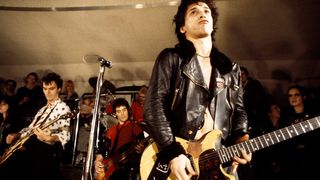“Me and Johnny Thunders basically put the Les Paul Junior on the map,” New York Dolls guitarist Sylvain Sylvain told gibson.com in 2009. “We called them ‘automatic guitars,’ like a car with an automatic transmission – easy to use. The Les Paul Junior had two knobs and one pickup. You didn’t need to control two volumes at the same time. It was the perfect guitar for the New York Dolls because it was stripped down – like the band was and like our songs were.”
The guitar that would become a punk icon, aka the single-pickup Gibson Les Paul Junior, was launched in 1954 as a more affordable alternative to the higher-spec twin P90-loaded Les Paul Goldtop model. While your full bhoona Les Paul had a mahogany body with an arched maple cap, the Junior was stripped back with only a slab of mahogany acting as its chassis.
Like its pricier sibling, the Junior had a single cutaway and a 24.75” mahogany neck (although some three-quarter scale maple-bodied Juniors were built) with a 12” radius rosewood fingerboard but yeah, just the one singlecoil P90 pickup wired through a master volume and master tone. Finish options? A brown to yellow sunburst was your whack, Jack. The back and sides of the body, and the rear of the the neck, were finished in brown nitrocellulose lacquer.
While Gibson made subtle modifications in ‘56 to add stability to the wrap-around bridge/tailpiece, the big shakeup occurred in 1958 when the Junior was re-profiled with a double cutaway silhouette.
With respect to our old pal Sylvain, the Junior really acquired iconic status because of Johnny Thunders alone. Dear sweet Johnny was probably the sloppiest influential guitarist this side of Johnny Cash’s Luther Perkins. He unwittingly gifted Sex Pistol Steve Jones his stage moves and was a big influence on Roddy “Radiation” Byers of The Specials not to mention every kid on the Sunset Strip in the 80s.
- The Guitars That Built Rock: The Gibson SG
- Every Home Should Have One: New York Dolls' Debut Album
- The Guitars That Built Rock: The Fender Telecaster
- So Alone: The Johnny Thunders Story
The proto-punk legend was pictured clutching a two-pickup ‘55 Les Paul Special on the the Dolls’ second album, Too Much Too Soon, but it was Johnny’s ’59 Les Paul TV Junior that became his most famous six-string compadre.
Why TV? This yellowish lacquer finish was apparently designed to stand out on black & white television as sunburst guitars looked too dark. Whether it’s true or not, TV Yellow is one of the earliest “Marmite” guitar paint jobs. Hey, it was cool enough for Johnny T.
The highest profile Junior player of recent years is Billie Joe Armstrong of Green Day. In the mid-noughties Gibson produced a signature model for the modern punk icon based on “Floyd” his original 1956 Les Paul Junior. While the signature had the classic 50s body shape and single-pickup, it featured a slimmer 60s style neck and a stacked P90; the latter designed to improve on the noise associated with traditional P90 pups. Billie Joe has also had the pleasure of a double-cut post-58 style Les Paul Junior signature.
In 1955, Gibson unveiled a two-pickup upgrade to the Junior called the Special. Like its baby-faced brother, the Special was originally spec’d with a single-cutaway before being rebooted with a double cutaway in 1958. Other upgrades include a pearl inlay headstock logo - as opposed to the Junior’s silkscreened item - a bound fingerboard and two volumes, two tones and a three-way pickup selector toggle switch. The Special has become most associated with 70s John Lennon - after he left his Beatle era Epiphone Casino and Rickenbacker 325 guitars at home - and reggae superstar Bob Marley.
By 1961, the single cutaway Les Paul models were dead as Dillinger. Gibson tried to resuscitate its fortunes by switching to a pointy twin-cutaway body shape. Initially named “Les Paul Models” these guitars became better known as the Gibson Corporation ass-saving SG range, as loved by Beatle George, AC/DC’s Angus Young and Sabbath’s Tony Iommi. The Juniors and Specials also influenced the birth of other budget Gibson models including the Melody Maker, as modified and made famous by ex-Runaway Joan Jett.
So far, we’ve rumbled on about the Junior as one of the great punk machines - and reggae skank planks too of course - but a slab mahogany body/P90 pickup combo is also the balls for hard rock. Here’s a classic clip of Leslie West in his early salad dodging years brandishing his Les Paul Junior with Mountain.
For years, those old Les Paul Juniors languished in attics, under beds, and in pawnshops… hence the term “pawnshop prizes”. What people hadn’t realised - yet - was that Gibson’s cheaper offerings were tonal giants so guys like Johnny Thunders could pick up these ancient “student” guitars for peanuts. Not so these days. A 50s Les Paul Junior in good shape will set you back up to a very un-punk five grand. The good news is there are a bunch of sub-£1000 Gibson and Epiphone replicas available not to mention a load of more expensive Custom Shop models. Looking and sounding as cool as Johnny Thunders is within your reach. Finding a pair of his white patent platform boots might be a bit harder to pull off…
Cult Heroes: New York Dolls - the band who found it hard to stay alive


